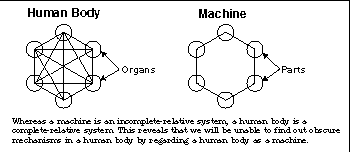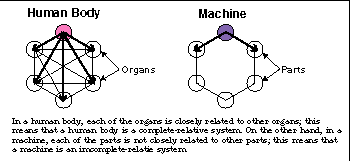 |
 |
|
|
|
 |
I. Human Body 1/4
First of all, we should understand the special characteristics of a human body in order to clearly analyze disease. |
|
|
|
|
|
|
1. A Relative System
|
|
A human body differs in system from a machine. Whereas a machine works as an incomplete-relative system, a human body works as a complete-relative system. Thus, compared with parts in a machine, organs in a human body function by closely cooperating with each other. Just this mechanism allows a human body to maintain the life as long as possible.
This viewpoint is important when we analyze disease. Usually when we medical researchers try to check obscure mechanisms in a human body, we tend to check them as if we check parts in a machine. However, even if we medical researchers check disease by regarding a human body as a machine, we will be unable to find out the true mechanisms in a human body. Why? This is because a human body is different in system from a machine. Thus, before checking obscure mechanisms in a human body, we should understand the difference between a human body and a machine. |
|
|
|
 |
|
(Whereas a machine is an incomplete-relative system, a human body is a complete-relative system. This reveals that we will be unable to find out obscure mechanisms in a human body by regarding a human body as a machine.) |
|
|
|
|
|
|
Specifically, compared with a part in a machine, an organ in a human body maintains close relationship with other organs. As already explained above, whereas a machine is an incomplete-relative system, a human body is a complete-relative system. Because of this reason, each of the organs in a human body is closely related to other organs. However, in a machine, each of the parts is not closely related to other parts. This is the special characteristic of a human body, and which plays an important role not only in maintaining the health but also in causing disease. |
|
|
|
|
|
|

|
|
(In a human body, each of the organs is closely related to other organs; this means that a human body is a complete-relative system. On the other and, in a machine, each of the parts is not closely related to other organs; this means that a machine is an incomplete-relative system.) |
|
|
|
|
|
|
All in all, we medical researchers will be unable to find out obscure mechanisms in a human body without understanding the difference between a human body and a machine. A human body consists of organ; a machine consists of parts. In this sense, a human body and a machine certainly resemble each other. However, a human body and a machine differ in system; that is, they are a complete-relative system and an incomplete-relative system respectively. Thus, unless we medical researchers understand this difference between a human body and a machine, we will be unable to find out the fundamental cause of disease including cancer. |
|
|
|
|